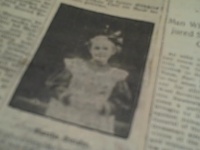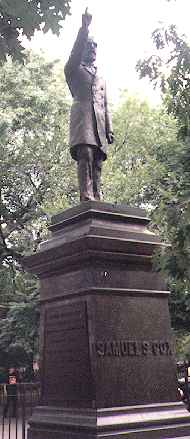From The Peopling of New York City
This video was meant to have music over it, and it's a slideshow of stills from videos on my Flipcam, pictures dating back decades, political cartoons and pictures of Tompkins Square Park.
A Journey into History: A Project Made of Mistakes
Welcome to the Project inspired entirely by my mistakes. Beginning in Middle Village, at Atlas Mall, and ending in the heart of Alphabet City, Tompkins Square Park, my project took me on a tour of New York City, and it ended somewhere even I didn't expect. This project will follow my journey that had me trawling through internet records for people who didn't exist, into archives to find who those people really are, hitting dead ends while I was at it, and finally into a park that sprawls over a good four blocks of what is now Alphabet City, but was then Kleindeutschland, or Little Germany.
A big part of the development of the undertaking here was my research into the General Slocum project. It first drew my interest in high school, when I read a book called "Ship Ablaze", which is similar in style to the book we read early on in the year by Jill Lepore, "New York Burning." It drew me in in a similar manner, and I became very interested in the disaster. So when the time came to pick a place, I wanted to take my location and turn it into a study on the General Slocum disaster and the aftermath, and how that has shaped the way we see things now. But when I kept hitting dead ends in both my research and my writing of the project, I decided to take things in yet another direction, and focus not on the monument I started with, but with the monument I had passed every day on my way to work, but hadn't realized could help me with this project. So I took an impromptu trip to Tompkins Square Park, where I saw not only the General Slocum memorial, but three more, the Temperance Memorial Fountain, the Samuel S. Cox memorial, and the Ukrainian- American Flagstaff.
Alphabet City and the Lower East Side (also known as LES) are places where the forces of gentrification and inner city pride collide. Businesses and condominiums are popping up everywhere (chain stores are everywhere, and a huge blue condo building is just south of Alphabet City, within spitting distance of the Williamsburg Bridge, on Delancey Street. On the other hand, the ethnic and predominately Hispanic culture still prevails, the main examples of this being Clinton Street, which is a cross street on Delancey Street and morphs into Avenue B after Houston Street; and Avenue C, also known as Loisada Street, a play on the words "Lower East Side." Gentrification has played a big part in Alphabet City's recent history, especially in the riots of 1988, which are expanded on later on in the project. I found those interesting in particular because those riots were recent history, occurring just two years before I was born.
Tompkins Square Park is smack dab in the middle of Alphabet City, which is in the Lower East Side in Manhattan, between Avenues A and B, and East 7th and East 10th Streets. It's surrounded by larger than life locations, on its north side lies the Life Cafe, a real life cafe mentioned in the musical RENT, on the left and right, Avenues A and B, both avenues filled with their own histories, to the south, East 7th Street, and a bar that's also in the RENT saga.
This journey through history may not make sense, but it can be said that life does not make sense. And if history is just records of past life, than it can be assumed that there are many inconsistencies. I believe that this class, the Peopling of New York City, is more than about just history, it's about solving puzzles and finding things out about people and groups that you never even knew existed, let alone had their own subculture.
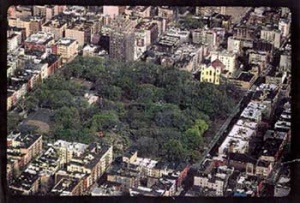
Overhead view of Tompkins Square Park to correspond with map on the right
Location Cheat Sheet
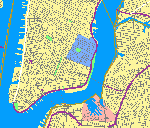
Borders of Alphabet City today
This is a rough approximation of where the five General Slocum victims lived. Here are the names of the five people and the information I was able to dig up from [Ancestry.com] (citation).
Notice how three of the five victims lived within blocks from each other. The other two aren't in the area per se. but they are still in the New York area.
DISCLAIMER: In my research, I have found that at least two of these names were spelled wrong. Anna Christina Lebnow is in actuality Anna Christina Leibenow, the older sister of the youngest survivor of the disaster, Adella Wotherspoon (nee Leibenow). Also, Pheobe Siewart is Pheobe Seigwart.
Take One: 80th Street and Cooper Avenue
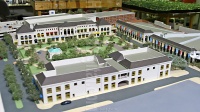
Computer rendition of Atlas Mall
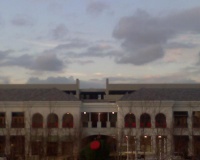
Picture overlooking the mall, facing the south end of the complex
The beginning of the journey to my final project is here, at the Shops at Atlas Mall. Boasting a myriad of stores, one of the few outdoor mall experiences in Queens, let alone the city, and not to mention one of the most expensive movie theaters of all time, The Shops at Atlas Mall garners thousands of visits a day. The experience Atlas Mall gives its visitors has also earned the raving review of New York Magazine, which voted Atlas, as it's normally called "the best local mall experience" in New York on its "Best of New York" page.
I live about a block and a half from here, and I was here before the mall had existed, so naturally the eyesore of a building that the complex used to be peaked my interest. But then I realized there were other historical treasures on my block, such as the cemetary across the street, which houses the Mafia's many deceased, and the second General Slocum memorial.
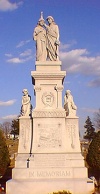
Middle Village Memorial at the All Faiths Cemetery
That was my first mistake, which led me to expand my project to not just that memorial, but all the way out to encompass the disaster in its entirety. The memorial wasn't in that cemetary, but the next one over, the Lutheran All Faiths Cemetary. There were two memorials, one in Middle Village, and one in Tompkins Square Park, in the neighborhood where the people of St. Mark's lived and worked.
"Welcome to The Shops at Atlas Park, a place where you can get away any day.
Atlas Park is the definitive destination for timeless sophistication. Our premium
shops, statuesque architecture and beautiful landscape come together to create an
experience that is like no other. Our shopping, dining and entertaining opens the
door to a memorable, culturally rich experience. Get away any day." [1]
Take Two: A Memorial to a Memorial: The General Slocum Disaster
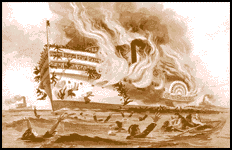
A depiction of the disaster
The General Slocum disaster, although not exactly a disaster everyone can name off the top of their heads, can easily be described as one of the deadliest disasters in New York's history, and probably the worst boat disaster in the city's history. Over thirteen hundred people boarded the General Slocum that day, over 500 of those being under the age of 20, and less than two hundred made it out to tell the tale. This was due to a whole bunch of reasons. For one thing, the safety equipment on the Slocum was useless, to say the very least, thanks to some faulty inspections that passed the Slocum without them deserving it. The lifejackets were filled with cork dust, which is dense and sinks, instead of actual solid cork, which floats. Most of the passengers strapped on useless lifejackets, which drowned them. For another thing, once the disaster was underway, the crew was largely useless, panicking along with the rest, despite that fact that they were crew members and were supposed to be prepared for anything. Yet another reason was the primitive life saving techniques of 1904. They didn't have CPR a century ago, so people that could have been saved weren't simply because the world then didn't have the knowledge we do now.[2]
Today, things like this happen, but we are more prepared for it now. We have hospitals, EMTs, proving methods for saving lives. We also have procedures that can save lives and avoid panics like the one that overtook all those people. Today, we have things that the New York in 1904 didn't have. This is one of the many ways we have progressed over the years. We can save lives now, travel great distances in the span of a few short hours, among other things. The disaster at the General Slocum marked a disaster, but it also marked a time of reform, where light was shed on things nobody took notice of, like boat inspections and safety equipment. The General Slocum disaster, at least for me, has shown me that although really bad things happen to very good people, undeserving people, that there's a reason for it, that there's something to be learned from it. Everything teaches, everything has a purpose, even the things that seem purposeless.
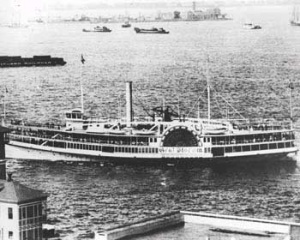
The Slocum before the disaster
Stats [3]
Built = 1891
Sunk = December 4, 1911
Previous names = Sank as Maryland
Depth = 24 feet
Gross Tonnage = 1,284
Dimensions = 236' x 38' x 7'
Type of vessel = Paddle wheel steamship
converted into barge
Builder = Devine & Burtis, Brooklyn, NY
Owner = Knickerbocker Steamboat Co.
Port of Registry = New York, NY
Cause of sinking = Foundered
Location = Ludlam Beach, NJ
Description
We open on Lower Manhattan, what we know today as Alphabet City, and what was once their Little Germany. Zoom in on St Mark's Church, a place where the neighborhood comes together, The church is led by one Reverend Haas, a young pastor who wants to serve the community well. They plan a picnic trip, but it requires a boat to get to their destination. Enter the General Slocum, a charter boat with a troubling accident record and a history of skimping on boat safety underneath her unassuming exterior. Over a thousand people boarded the General Slocum to embark to a picnic area that was beyond a pass known as Hell Gate. However, the General Slocum's fate was not tied to the Gate, but to a hellish fire within. [4].
Fire has always been a destructive force, and New York City has a collective fear and fascination with fire. A perfect example of this is a then newly minted Coney Island attraction that consisted of a small city that was set on fire for the enjoyment of the crowd, who would watch in awe and fear of the sheer force and destruction fire left in its wake. New York wasn't a stranger to fire either, if the fires of 1741 are any example. [5] Fire, or even the idea of fire, could set off deadly panics.
And that's exactly what happened on the Slocum, an overcrowded boat drowning in fire and panic,its passengers unable to save themselves, and a completely incompetent crew that was panicking worse than some of the helpless passengers, in the middle of a path called Hell Gate which ironically, wasn't earning its name this time. Passengers strapped useless life jackets onto their children, confident that the equipment could and would save them. One survivor interviewed in the book Ship Ablaze that he happened to be there with his mother and siblings, and he'd insisted to his mother that he could swim (a rare ability in 1904 New York) and to put the spare lifejacket on his youngest sibling. He was the only one who made it that day. Similar situations were playing themselves out all around them, where mothers were strapping their children to lifejackets and tossing them in, watching as they never came back out. [Ancestry.com death toll manifest]
Just as the congregation of St. Mark's (mostly women and children, most fathers and men weren't there" discovered that the life jackets were useless, they also found that the lifeboats were literally wired to the boat, "so they wouldn't creak," and the fire hoses were as good as useless. While the Slocum's captain, Captain Van Schiack, was deciding that it would make more sense to sail into the wind to North Brother Island, fanning the flames all the more, the passengers that were left were deciding by which element they'd rather die by, water or fire.
By the time it was all over, 1,331 people had gotten on the Slocum for a picnic adventure and a break from the city, over 500 of them under the age of twenty, and 1,021 people were either dead or missing. Captain Van Schiack had been judged by the law and sentenced to 10 years in the Sing SIng prison (he only served 3 1/2), but it didn't change the fact that over a thousand stories, a thousand lives, had been cut short.
[6].
My Five "Informants" [7]
My five informants were all strategically picked so they would be under the age of 21, and they range from near toddler to near adult. In order of age, my informants were Lena Ackerman (age 18 months), Anna Christina Leibenow (age 3), Hugo Zimmerman (age 12), Charles Gillis (age 16) and Phoebe Siegwart (age 16). (Archives at the New York Historical Society) My point in using these five specific individuals was that although children are our future, a boat fire and some faulty lifesaving equipment took the future away from five individuals who deserved a life after that church picnic that they didn't get.
I chose my informants randomly, out of the Ancestry database, but those records had typos on two of my five names, confusing "Liebenow" with "Lebnow" and "Siegwart" with "Siewart." Not wanting to assume that the Anna Lebnow I had was the missing sister of the youngest survivor of the disaster, I didn't assume that, not wanting to create any bias and make myself believe that this girl wasn't someone random, which was how I had picked her out to be. But after realizing that this indeed was a typo and I had bee right, I then dove into those records to find what I could about any of them, starting with Anna C. Liebenow, as I had a bit more to go on when it came to her. I researched her the way I researched the rest, typing in their last name and trawling through the records, or in the case of Anna C, I entered in the name of her father, Paul Liebenow, and her sisters, Helen and Adele (now Adella Wotherspoon). However, I was quite surprised to see that there was nothing on any member of the Liebenow family, except one Wikipedia article on Adella. Every spelling, every search turned up nothing in anything legitimate, even when I went back one, even two centuries. All five of my informants were the same way.
After deciding that Ancestry was a disastrous turn, I took a few trips to the New York Historical Society, which is inside a library next to the Museum of Natural History and its partnering planetarium, and took as many pictures I could of the badly decaying articles and pictures inside Paul Liebenow's scrapbook, which I had heard about in the book Ship Ablaze, even snapping a shot of who I believe is Anna C. Liebenow herself. Getting past the feelings of awe that I felt about being able to look at articles that had been painstakingly taped and glued into that book by Paul Liebenow for his daughter, that were over a century old, I turned page after page, hoping to find something, anything, that could give me a lead on anybody else. And although I didn't find anything that was helpful in tracking down any of my informants or any of their relatives, I was able to make certain inferences on the neighborhood. I could safely assume that most of the residents of Little Germany actually spoke German, which enforced what I already knew, the neighborhood was still steeped in the original culture that its people came from.
And even in the cases of the informants, I was able to find things out about them. In the original booklet given out at the Middle Village commemoration of the memorial for the disaster, everybody had an age listed, including my informants. It was here that I was able to find how old everybody was, and I was able to see that everyone had someone die with them, be it a sibling, or a parent in the case of 18 month old Lena Ackerman. They were just five members of a vanished people, that embarked on a picnic trip meant to be fun and exciting, but ended up being harrowing and painful for all involved, either directly or indirectly.
Although I knew that what is now Alphabet City was New York's Little Germany, I had always assumed that it was an Americanized, yet ethnic neighborhood, like the ethnic neighborhoods today. (Atlas Mall is in Middle Village, a very Italian American area, but it's not very easily seen. I had been living in the area for years and had no idea.). Yet most of the articles in that scrapbook were in German, and falling apart, due to them being a good 104 years old. It was at this point that I became interested in the forming of Alphabet City, where I spend a lot of time at anyway.
This leads us to...
Final Take: After the Mistakes: A History of Tompkins Square Park Spoken through its Statues
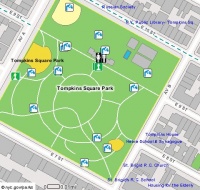
Still shot of the interactive map of Tompkins Square Park, labeling everything in it.
[8]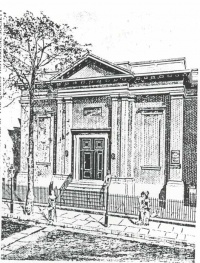
St Mark's Church was a fixture in the area around Tompkins Square Park, in the area formerly known as Little Germany. It's where Mayor Tompkins is buried, and it's the church congregation that took a blow to the heart during the General Slocum boat sinking disaster.
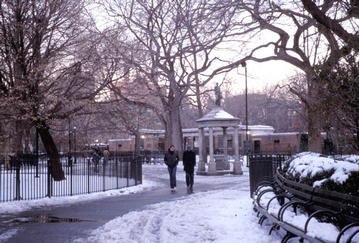
Tompkins Square Park in the winter
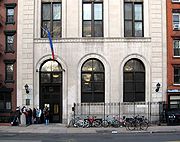
Tompkins Square Park Library branch
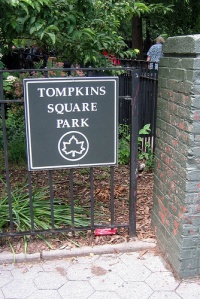
Welcome to Tompkins Square Park![9]
An East Village Wisdom (arguably no longer true)[10]:
* Avenue A, you're All right.
* Avenue B, you're Brave.
* Avenue C, you're Crazy.
* Avenue D, you're Dead.
Alternately:
* Avenue A, aware.
* Avenue B, beware.
* Avenue C, caution!
* Avenue D, DEATH!
I walk past Tompkins Square Park six days a week in the summer, on my way to work. It lies in the heart of Alphabet City, between East 7th Street and Tenth Avenue, just short of the Life Cafe (of RENT fame), and between Avenues A and C. Not only is it home to music, playgrounds, and more avenues of entertainment, it's the home to four monuments, and subsequently four tidbits of history.
Tompkins Square Park honors Daniel Tompkins, a former governor of New York and Vice President under President James Monroe. Its monuments inside commemorate the memory of a whole myriad of people, from a temperance activist, an abolitionist, and the unspoken hundreds of the community surrounding the park.
Tompkins Square Park has also been home to many changes that mirror the changes in New York, and subsequently history. Some of those changes are touched upon here. Whether it's a monument on temperance that brings clean water to the public, a statue of a man that had a hand in the history of two states, a memorial of over a thousand innocents who died needlessly, or just a flagstaff that illustrates our country's nationalism, Tompkins Square Park is a minefield of history, and some of those mines have been unearthed and exploded here.
TIMELINE
The story of Tompkins Square Park will be told through its various memorials, plus a rundown on where it was before the park came about and today.
Image:Music Video- The Peopling of New York City.mp4This video is a commemoration of my project, a sound version of the one at the top of this page.
The Temperance Memorial Fountain (1888)[11]
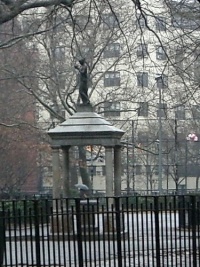
The Temperance Memorial Fountain
[12].
The Temperance Fountain dates back to 1888, and was the gift of a Henry D. Cogswell (1820-1900). It's in a neo-classical style, and has the mythical water carrying figure of Hebe standing atop a stone pediment. Hebe was originally made of zinc, but is now made of bronze. The statue is based off of the work of Albert Bertel Thorvaldsen (1770–1844), whose 1839 self portrait is in Central Park on E. 97th Street.
Cogswell was born in Connecticut, into a life that would take him to ORwell, New York, and back again. He rose through his circumstances, “eight years of labor in southern Connecticut and Rhode Island cotton mills, itinerant wanderings, and incarceration in a poorhouse.", became a principal and subsequently a dentist. He was then lured to San Fransisco by news of the California Gold Rush. There he continued his dentistry practice, and his business plus some real estate ventures let him retire with a fortune of roughly 2 million dollars. He then went into philanthropy, and helped springboard the anti temperance movement. He founded the Cogswell Polytechnic Institute as well.
This monument is one of fifty, and all were made between 1871 and the 1890s, and most were replicas of the temperance fountain, and can be found in places like Boston and Washington D.C. Cogswell put four columns on some, including the one at Tompkins Square Park, and each column is "emblazoned with the words Faith, Hope, Charity, and Temperance." It was erected because of Cogswell's affiliation with the Moderation Society, which he was a honorary president of. The Moderation Society was formed in 1877, and its purpose was to encourage citizens to drink clean water instead of alcohol, and the fountains were a way to get that icy, clean water to them.
.
The Samuel S. Cox Memorial (1891)
Samuel S. Cox's claim to fame comes fron being a prominent journalist and political leader in 19th century Ohio. He was born on September 30th, 1824, in Zanesville, Ohio. He started off at Ohio University, but transferred to Brown University in Rhode Island, then went back to Ohio to run his own law practice, specifically in Cincinnati. He started his newspaper career in 1853, at the Ohio Statesman as an editor. He was a active Democrat, and used his paper to further spread democratic party ideals and ideas. In 1855, he served as the United States ambassador to Peru, but came back a year later to serve in the House of Representatives for four consecutive terms. Cox opposed the Civil War, not unlike many other Ohioans of the day, supported Clement Vallandigham, but his power began to wane during the Civil War. He also used to verbally attack the president, like Vallanddigham, but with even more conviction. Cox, although he was a Democrat, didn't share the Democratic beliefs of his day, that slavery should be allowed to exist anywhere, so when the thirteenth amendment to the Constitution came up, he supported it, so slavery could be outlawed in the United States as a whole. This, however, was the beginning of the end of his stint in power in Ohio, as a great majority in that state supported slavery. THis did not end his political career, however, and he ended up moving to New York, where he started a law practice, and for two years became the U.S. ambassador to Turkey. In the end, he ended up back in the House of Representatives, only in a different state, and served there until his death in 1889[13]. .
"The statue is nicknamed 'Taxi' because it looks like Cox is hailing a cab. (An actual statue of a man hailing a cab, called "Taxi" can be found at Park Avenue and 48th Street."[14].
The Slocum Memorial Fountain (1906)
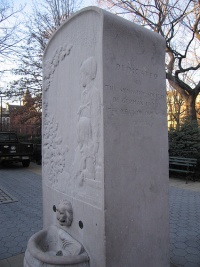
The Slocum Memorial Fountain
"In 1906, a 9-foot tall monument to the victims of the June 15, 1904 General Slocum steamboat disaster in which 1,000 people perished due to gross negligence on the part of the boat operators was erected in Tompkins Square Park: a small 9-ft. stele made of pink Tennesee marble, featuring a relief picturing two children looking seaward, sculpted by Bruno Louis Zimm. Funds were provided by the Sympathy Society of German Ladies. In 1991, it was restored by the NYC Parks Department with funds from SUNY-Maritime College in Throgs Neck, Bronx. The children are described: "They were earth's purest, children young and fair." A larger monument can be found in Lutheran All-Faiths Cemetery in Maspeth, Queens: see my North Brother Island page for a look. [15].
(More information in Take Two.)
The General Slocum disaster cut over a thousand lives short, and affected everyone around the victims, and as Kleindeuchland was a very close knit community, everyone around that church was affected, nay, everyone in that neighborhood was affected. This monument was one of two, the other lies in the middle of the Lutheran All Faiths Cemetery in Middle Village, Queens.
This is the monument that links my General Slocum research to my Tompkins Square Park research, and most of the information surrounding the events that led up to the building of this monument is in the part of my project labeled "Take Two," the section dedicated to my General Slocum research. Both sides of my research are in my video, which is at the top of this page in silent form and under the TIMELINE section with sound.
The German Americans that used to live in the Alphabet City area started moving out after that, and Easter European Jews started taking over the newly vacated space, looking for religious freedom. By 1910, the population in the are had grown so much that it was roughly the most densely popular neighborhood in the country.[16].
The Ukrainian American Flagstaff (1942)[17]
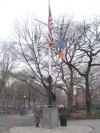
The Ukrainian American Flagstaff
Location: Near park office
Description: Flagstaff on base with plaque and seal
Materials: Base--granite, plaque and seal---bronze
Dimensions: Base H: 5' W: 3'4 ½" D: 3'4 ½"
Cast: 1942
Dedicated: 1942
Donor: Ukrainian Production Unit of the American Red Cross
The Ukrainian American Flagstaff is unique from all the other monuments in the sense that I couldn't find any information on it. The information above was all that was available to me. However, I think this is very telling. Consider the time period this monument came from, World War Two. It was a time where the entire world was at odds, and a time where the American people were involved in a struggle to save the world from a force that was threatening to take over everything. Even in this time of uncertainty, and probably because of it, Americans developed a love for their country. To me this is probably why this flagstaff was made, to show patriotism in a time where everything was uncertain.
Tompkins Square Park Riots (1988)
This is a video of a discussion on the 1988 Tompkins Square Park riots. (SOURCE: Philip Vanaver's YouTube account)
The Tompkins Square Park riots of 1988 were about gentrification, which is a bit ironic, because today most of Manhattan is virtually inaccessible unless one is white and rich. The East Village had become "a dangerous slum" and Tompkins Square Park had been reduced to a hangout for drug dealers. In 1986-1987, the Christadora House was converted, joining the park with condominiums, thus igniting the wrath of neighborhood residents, who feared gentrification and higher rent costs, and the enforced curfew in the summer of 1988 only served to make things worse, and August 6th marked the beginning of rallies and demonstrations that would begin the Tompkins Square Park riots.[18]

An encampment in an empty lot
Starting on August 7th, and continuing till early August 8th, a few hundred supporters of the cause faced off with the police, which was armed like an army, and things quickly turned ugly as the police started clubbing civilians in the streets. Protesters from all walks of life collectively took up chants like "No police state" and "It's our fucking park, you don't live here!" and held up banners like "1988=1933, Revolt" and "Gentrification is Class War," even going to far as to throw bottles and exploding firecrackers. It was clear that the conflict was revealing all kinds of conflicts, be them political, economical, or cultural tensions along class and ethnic based lines and factions. By the fall of 1988, the public was fascinated with what could be called a tent city in Tompkins Square Park, and by 1989, over 200 squatters were living in shacks all over the park. When the park was sealed off in July 1989, 250 police officers had come to do the job, giving everyone 15 minutes to gather their things and get out, but the park was filled with more people by the fall of the same year. But on December 14, 1989, the park was subdivided into six sections, cleared of all homeless, and by 1991, the park was closed down for renovations.[19].
The Gentrification of the Lower East Side. This video was a first place winner at the CUNY Video Slam 2008.
Cut, Print, That's a Wrap: CONCLUSION
The General Slocum disaster was a terrible disaster that took many lives, but out of all the darkness of that day, it shed some light on some very corrupt things that led to the disaster in the first place, and it led to a lot of changes in how things were done. This just goes to show how resilient we are as New Yorkers, and how resilient New York is as a city. We bounce back, no matter what's thrown at us. Life might not make any sense, making history not make sense, but one thing that does without any explanation is how when adversity hits our collective city, we come together, despite those pesky divides of politics and economics and class. This, more than anything else, makes our city special, more than just the skyscrapers and lights, but the very soul of the city. The soul of our city isn't in what's in our city, it's who's in our city.
Tompkins Square Park is a place that has changed immensely over the years, be it in aesthetics, where every few years a new monument would come up (The Temperance Fountain and the Samuel Cox memorial came up within five years of each other) or in beliefs (the riots of 1988 are only the most recent of the riots that have taken place there). Personally, I think that Tompkins Square Park is a picture of the turbulence that the Lower East side has always embodied, be it in its general conflicts, or something specific, like gentrification. But no matter what happens in the Lower East Side, it doesn't change its history. No amount of gentrification can change the neighborhood that housed an entire community of German immigrants that, and the Eastern European Jews after them. History may be filled with juxtapositions and ironies, but in the Lower East Side, these juxtapositions seem to have found their home.
And Now, A Bit About The Researcher...
Christine L. Rivas is a second term freshman at Brooklyn College. She is undecided on paper, but a creative writing major at heart, and has dreams of combining her interest in writing and her interest in theater and becoming a playwright or a screenwriter. She enjoys theater, writing, history, music, getting good grades, and of course, writing huge undertakings of projects like this one. She had a lot of fun with this.
MLA CITATIONS
[1] "Alphabet City: Encyclopedia II - Alphabet City - Trivia." Global Oneness - The meeting place for Cultural Creatives - Articles, News, Community, Forums, Travel & Events and much more. April & may 2009 <http://www.experiencefestival.com/a/alphabet%20city%20-%20trivia/id/4785568>.
[2] General Slocum Memorial Service. Lutheran All Faiths Cemetery, Middle Village, New York. March & april 2009.
[3] "GENERAL SLOCUM." NUMA - National Underwater and Marine Agency founded by Dr. Clive Cussler. Feb. & march 2009 <http://www.numa.net/expeditions/general_slocum.html>.
[4] "The History of Tompkins Square." Curbside Media. March & april 2009 <http://curbsidemedia.org/tompkins%20square%20history.html>.
[5] Lepore, Jill. New York Burning Liberty, Slavery, and Conspiracy in Eighteenth-Century Manhattan. New York: Knopf, 2005.
[6] O'Donnell, Edward T. Ship ablaze the tragedy of the steamboat General Slocum. New York: Broadway Books, 2003.
[7] Parks Department. "Tompkins Square Park :." New York City Department of Parks & Recreation. NYC Parks Department. March & april 2009 <http://www.nycgovparks.org/parks/tompkinssquarepark/>.
[8] "Permanent Art and Monuments :." New York City Department of Parks & Recreation. April & may 2009 <http://www.nycgovparks.org/sub_your_park/monuments/monument_info.php?monId=1587>.
[9] "Samuel S. Cox - Ohio History Central - A product of the Ohio Historical Society." Ohio History Central - An Online Encyclopedia of Ohio History - Ohio Historical Society. 1 July 2005. April & may 2009 <http://www.ohiohistorycentral.com/entry.php?rec=71>.
[10] "Selling the Lower East Side - The Politics and Culture of Urban Resistance." University of Minnesota Press. 2000. March & april 2009 <http://www.upress.umn.edu/sles/Chapter8/ch8-1.html>.
[11] The Shops at Atlas Park. Jan. & feb. 2009 <http://www.theshopsatatlaspark.com/>.
[12] "Temperance Fountain - Historical Sign." New York City Department of Parks & Recreation. April & may 2009 <http://www.nycgovparks.org/sub_your_park/historical_signs/hs_historical_sign.php?id=12753>.
[13] "Tompkins." Forgotten NY. April & may 2009 <http://www.forgotten-ny.com/SLICES/tompkins/tompkins.html>.
[14] "Tompkins Square Park, Manhattan." Welcome to Partnerships for Parks. April & may 2009 <http://www.partnershipforparks.org/brochures/tompkins_square.html>.
FOOTNOTES
- ↑ http://www.theshopsatatlaspark.com/
- ↑ O'Donnell, Edward T. Ship ablaze the tragedy of the steamboat General Slocum. New York: Broadway Books, 2003
- ↑ <http://www.numa.net/expeditions/general_slocum.html>
- ↑ O'Donnell, Edward T. Ship ablaze the tragedy of the steamboat General Slocum. New York: Broadway Books, 2003
- ↑ Lepore, Jill. New York Burning Liberty, Slavery, and Conspiracy in Eighteenth-Century Manhattan. New York: Knopf, 2005.
- ↑ O'Donnell, Edward T. Ship ablaze the tragedy of the steamboat General Slocum. New York: Broadway Books, 2003
- ↑ General Slocum Memorial Service. Lutheran All Faiths Cemetery, Middle Village, New York. March & april 2009
- ↑ Parks Department. "Tompkins Square Park :." New York City Department of Parks & Recreation. NYC Parks Department. March & april 2009 <http://www.nycgovparks.org/parks/tompkinssquarepark/>.
- ↑ "Tompkins." Forgotten NY. April & may 2009 <http://www.forgotten-ny.com/SLICES/tompkins/tompkins.html>
- ↑ "Alphabet City: Encyclopedia II - Alphabet City - Trivia." Global Oneness - The meeting place for Cultural Creatives - Articles, News, Community, Forums, Travel & Events and much more. April & may 2009 <http://www.experiencefestival.com/a/alphabet%20city%20-%20trivia/id/4785568>
- ↑ "Temperance Fountain - Historical Sign." New York City Department of Parks & Recreation. April & may 2009 <http://www.nycgovparks.org/sub_your_park/historical_signs/hs_historical_sign.php?id=12753>
- ↑ Temperance Fountain - Historical Sign." New York City Department of Parks & Recreation. April & may 2009 <http://www.nycgovparks.org/sub_your_park/historical_signs/hs_historical_sign.php?id=12753>
- ↑ Samuel S. Cox - Ohio History Central - A product of the Ohio Historical Society." Ohio History Central - An Online Encyclopedia of Ohio History - Ohio Historical Society. 1 July 2005. April & may 2009 <http://www.ohiohistorycentral.com/entry.php?rec=71>
- ↑ "Tompkins." Forgotten NY. April & may 2009 <http://www.forgotten-ny.com/SLICES/tompkins/tompkins.html>
- ↑ "Tompkins." Forgotten NY. April & may 2009 <http://www.forgotten-ny.com/SLICES/tompkins/tompkins.html>
- ↑ "The History of Tompkins Square." Curbside Media. March & april 2009 <http://curbsidemedia.org/tompkins%20square%20history.html>
- ↑ Permanent Art and Monuments :." New York City Department of Parks & Recreation. April & may 2009
- ↑ "Tompkins." Forgotten NY. April & may 2009 <http://www.forgotten-ny.com/SLICES/tompkins/tompkins.html>
- ↑ Selling the Lower East Side - The Politics and Culture of Urban Resistance." University of Minnesota Press. 2000. March & april 2009 <http://www.upress.umn.edu/sles/Chapter8/ch8-1.html>








